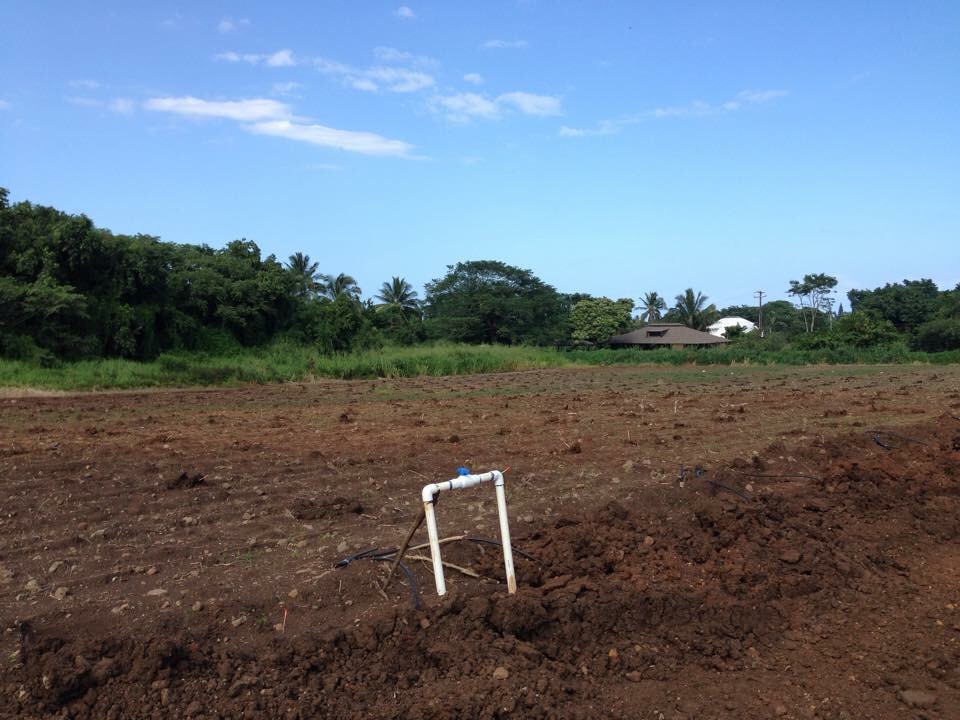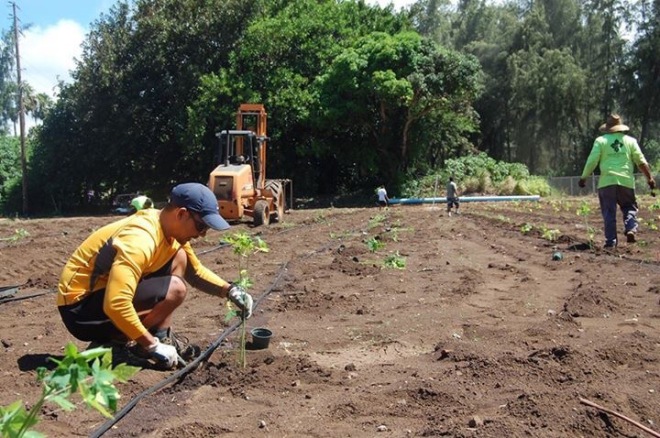
Let’s talk farming. Real farming, not those 2 acres of various things you’re growing on a gentleman’s “farm.” This farm is one that will earn you a living for years to come and hopefully allow you feed your family, put them through school, keep a roof over your head, and help you to retire.
What will you need to farm? Land. Lots of it to produce enough income to pay for the inputs you need. Let’s say a decent family farm in Hawaii like ours leases some 30 acres. That costs some couple thousand a month in lease payments depending on where it is or if you purchased it, at least another $3000 a month.
Once you have that land to farm, you’ll need the infrastructure set up to grow your crop. You’ll need pipes and irrigation lines and sprinklers here and there to cover those thirty acres. Add at least $5000 for those things and add another several thousand for the labor to put that all in too.
After you’ve got your field set up, it’s time to plant it. You’ll need a tractor to plow your field. A decent one will cost you at least $40k. A plowed field also needs plants that have to be sheltered in a greenhouse to get to a decent size to survive. A greenhouse is another several thousand dollars to build with the parts and labor. The seedlings need medium and planting trays to start also. Add in a few more thousand dollars to the supplies and labor needed.
Trees don’t exactly plant themselves so there is the cost of labor to get them in the ground. To give them a head start, a pinch of fertilizer in the holes help. A bigger tree is more likely to survive a wild pig trampling too. These wild creatures can tear up a field in a matter of minutes.
You will be paying on the loans or be out a lot of money for at least 4-6 months before you get a crop. You’ve paid hundreds for labor dollars and inputs only to have to wait for the harvest. As a business owner, you’re required by law to pay your workers and cover their benefits, but you aren’t guaranteed a salary.
When the crop is ready, you need harvesting equipment like a forklift and bins to store you’re fruit in. Can’t forget that all of these things also must past food safety certification. That certification cost at least $3000 to acquire and another thousand to set up the equipment needs to meet it. You will have to spend some extra money leading a portapotty to keep on your field too and hope no one steals it.
It will take several months for your trees to grow to produce fruit. However, there still is work to be done. Thatincludescleanung the trees of dead leaves and thinning out fruit so that you get nicely shaped ones for the market. Odd shaped fruit can’t get premium prices. The thinning of the fruit has to happen weekly since the flowers bloom all year round and it takes a year from flower to fruit. You’ll also hope and pray that mites, parrots, chickens, or other elements don’t disturb or damage your columns of fruit.
You’ve waited nearly 6 months and your first crop arrives and it’s time to harvest. After you’ve picked your fruit, you’ll have to prepare it for market, which means washing and packing it. Someone has to build the processing plant for this to happen. It’s not free and will cost you around $8,000 for the time, labor, and supplies.
Let’s not forget that the papayas do have to be packed into something to get to the market. Those boxes cost about $2 a box and minimum orders are several thousand. In a week, one can harvest at least 200 plus cases. A good order of boxes will put you out $15,000 or so. You can’t reuse them either because of food safety regulations, so that increases your cost too.
Recall that you haven’t even sold your crop yet at this point. You still have to pay your workers’ wages, work man’s comp, benefits, and other bills you’ve gotten just to start off your farm.
I don’t know of a single local person that can be out some $225,000 to start their business. It’s not even guaranteed that you’ll get a return on investment either. If activists ban ag technology or crop protection products without a validated reason other than Google, or a flock or invasive birds nibble at your crops, you are still obligated to pay back what you owe. With nothing to sell, you’re bleeding more money. No one wants to dig a deeper hole!
While hundreds will meet to plot the demise of corporate agriculture this weekend, the small farmers in Hawaii are still saddened by the ceasing of the Maui sugar plantation and Richard Ha’s beloved Hamakua Springs Farm. The ag community knows that so many other long time local farmers face the same challenges in Hawaii. The ag sector has been attacked and our state’s bad reputation for being small business friendly doesn’t bode well for that pretty word circulating but never put into real policy to take it to action. That word is sustainability.
It’s great that there’s so much talk about it but it’s clear that we aren’t practicing what we preach. We say buy local but then put policies that impede locals from producing products made here. We need to look at the larger picture about why business are closing and the local folks are jobless. Where’s the investment to keep the kamaaina working and productive? Are we supporting those policies and putting it into action?
Let’s face it. There’s few folks willing to put down some $250K on a risky back breaking business venture like farming. It’s easy to TALK diversified ag as the savior to keep ag lands in ag, but unless we get some systemic changes on the business and political environment, you won’t see it happening in a flash. There’s no massive populace raising their hands to be farmers.
This weekend is the Food Justice Summit but it needs to change its name to the Farmer Justice Summit. More people need to learn from the local farmers still in business now rather than international speakers who know nothing about Hawaii other than Monsanto’s presence. Don’t forget that without local farmers, you can’t have locally grown food.
Support the local farmers with your wallet as well as your voice for better policies to sustain them for the future.



Yep
Right on target Joni! Another blog entry that explains exactly what farmers have to consider and contend with if they are going to be profitable (gasp!). When you are on the outside looking in it seems so easy. The good farmers (the ones that have been at it for decades) have learned how to cope and adjust to all of the strains and stresses of agriculture. And that list includes weather and climate, irrigation, insect, disease, weed competition, harvesting, packaging, and marketing. The latest challenge to small family-owned farmers is the pressure to provide 3rd party documentation that their farms and ranches follow Good Agriculture Practices (GAP) with respect to bacterial/fungal contamination and food-borne illnesses. In that respect GMO corn has greatly improved the storability of corn and soybeans. This is because of traits that control key pests that can be established in the crop and cause accelerated decomposition, along with toxins such as aflatoxin, that can grow in storage and render the farmers crop useless as a food or feed item. The GMO grain suffers very little by the very nature of the product. This is what we, as farmers, consider a bright light for continued sustainability. So, to all the naysayers out there I say walk a mile in our shoes before making any self-righteous declarations regarding the way modern farmers choose to manage their farms and ranches. I suspect if they did that we would have a lot more accommodating comments on your blog and others that try and educate the public from the farmers perspective.
Keep up the good work!
Thank you John for always educating. That is what we need to see for the future. We will be better off by supporting education indeed.